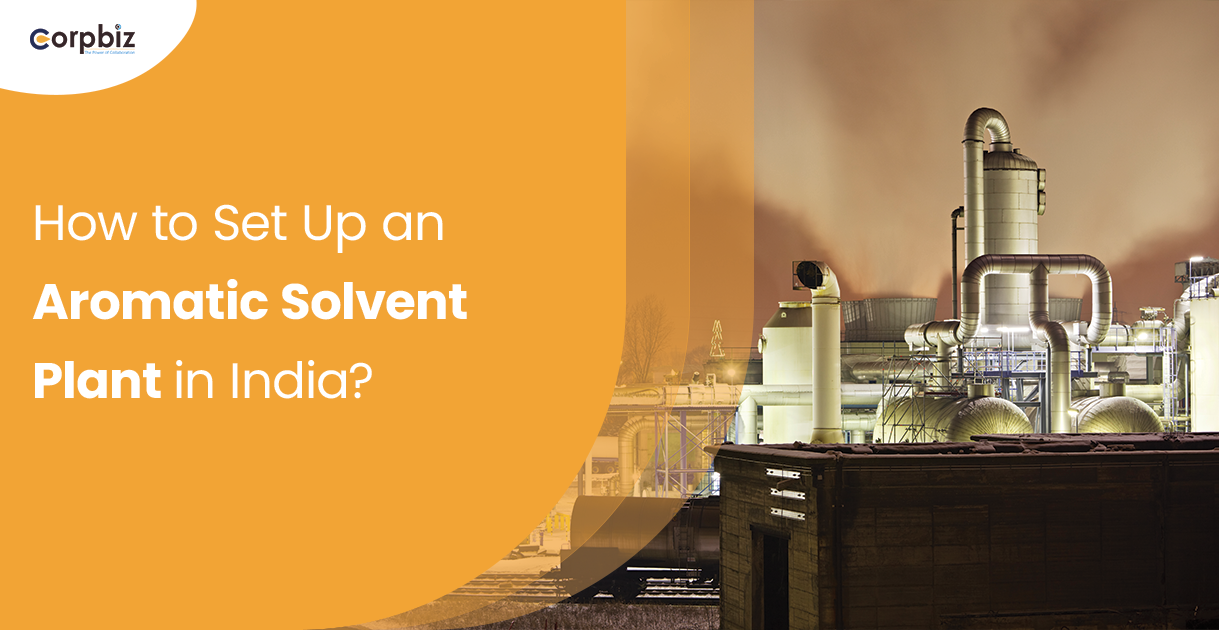Aromatic solvents are a very important component used in many industries, such as paint, coating, chemicals, etc. They are well known to have two distinct qualities: they can dissolve materials and the aromatic compounds derived from petroleum. Therefore, opening up an aromatic solvent plant in India is possible, and it would be considered profitable as the market keeps expanding for aromatics in domestic and international markets.
However, setting up the plant is not an easy task as it requires detailed planning and strict adherence to rules. It also demands huge investments. This blog will help you understand the essential steps needed for setting up an aromatic solvent plant in India.
What are Aromatic Solvents?
The aromatic solvents are the type of organic compounds which contain at least one benzene ring within their molecular configuration. The leading examples are toluene, xylene and benzene. These solvents are utilised in the industrial process in large volumes because they have a very high solvency capacity and can easily dissolve a wide range of materials.
Applications and Uses of Aromatic Solvents
A wide range of applications and uses of Aromatic Solvents are as follows:
- Paints and Coatings: Aromatic Solvents are used in improving the properties of paints and applications of paint.
- Adhesives: Aromatic solvents help bond the materials by dissolving the polymers.
- Chemical Synthesis: Aromatic Solvents serve as intermediates to many chemical reactions.
- Cleaning Agent: Aromatic Solvents are found suitable for cleaning activities in industries.
Guide to Setting up an Aromatic Solvent Plant in India
1. Feasibility Study
The primary step that needs to be taken prior to the commencement of the project is a comprehensive feasibility study. Therefore, this study involves the following analysis that needs to be done:
- Market Analysis: You must study and analyse the demand-supply status, target customers and competitors.
- Technical Feasibility: You must assess and consider the appropriate technology to be used, how the production will be done, and any potential suppliers and sources of raw materials.
- Financial analysis: You need to estimate the capital investment involved, operating costs and the expected returns.
2. Business Plan
A comprehensive business plan should necessarily secure financing, potential investors, as well as day to day management. Hence, a business plan should cover the following:
- Executive Summary: The background of the breakdown of the project and the introduction of goals and objectives needs to be covered.
- Market Strategy: They must cover marketing and sales strategy in order to secure markets.
- Operational Plan: A detailed plan for a plant’s operations, such as production schedules and logistic plans, needs to be made.
- Financial Projections: Income statements, statements of financial position, balance sheets, statements of cash flows and profits & loss forecasts need to be covered.
3. Location Selection
Choosing a location is an important factor; therefore, choosing the right location for a plant will play a major role in determining its fate and success. In order to choose the right location, one must consider the following points:
- Raw Material Proximity: This will allow the population to access petroleum products easily.
- Infrastructure: You should ensure that your chosen location has facilities like water, electricity and transport links for smooth functioning.
- Regulatory Environment: Adherence to local zoning laws and environmental regulations is a must.
4. List of Regulatory Approvals
Setting up a chemical plant involves compliance with various regulatory requirements. Therefore, the list of regulatory approvals needed for setting up an aromatic solvent plant is as follows:
- Environmental Clearances: To ensure your conformity with environmental standards, you need to obtain environmental clearances from the Ministry of Environment, Forest and Climate Change (MoEFCC).
- Factory License: You must provide a code of conduct, and Registration of the plant under the Factories Act 1948 is a must and an essential requirement.
- Pollution Control Board: Approach the State Pollution Control Board to get approval for the emission standards.
- Safety and Approvals: You must comply with the existing and standard of safety prescribed by the system shall ensure compliance with the safety standards laid down by the Directorate General of Factory Advice Service and Labour Institutes.
5. Technology and Equipment
- Sourcing technology: Solicit and purchase current, improved, and new aromatic solvent production technology. Ensure that you work with technology providers that can provide better and more effective production methods.
- Equipment Procurement: You must acquire good machines and equipment that will lead to smooth and efficient operations. The key equipment would be the following:
- Reactors and Distillation Units: Reactors and distillation units are essential for the successful extraction of solvents and the purification of those that have been used as solvents.
- Storage Tanks: Storage Tanks are widely used for storing raw materials and finished products, which they then supply to the market.
- Quality Control Instruments: Quality Control Instruments ensure that the quality and standard of the product produced are not compromised and comply with the requirements.
6. Construction and Installation
- Plant Layout: You must consult with experienced engineers, who will help you arrange and lay out the entire plant design to enhance the flow of work and safety guidelines.
- Construction: You must ensure that the company hires proper contractors to construct the plant. This should be done while closely monitoring the progress to ensure timely completion of the plant.
- Installation of Equipment: Once the construction work is completed, the machinery and equipment to be used in the operation will be installed. You shall also carry out the test and commission everything in order to ensure that it is all working well.
7. Manpower Recruitment and Training
- Hiring staff: You must actively participate in recruiting skilled personnel within the company, ranging from production and quality control to maintenance and administration.
- Training Programs: Provide the staff with comprehensive training programs in order to teach and equip them with the necessary skills and knowledge on how to operate the plant efficiently.
8. Production and Quality Control
- Raw Material Procurement: You must maintain a good source for the supply of raw materials, bargain for the best terms possible, and maintain a satisfactory inventory level.
- Production Process: The company should adopt a stable and efficient procurement strategy to achieve maximum efficiency without creating a significant amount of waste. Periodically assessing the production process for enhancements is recommended.
- Quality Control: Establishing an efficient quality management system is crucial to upholding high standards. Therefore, to ascertain the final product’s quality, you must carry out regular inspection or testing of the product.
9. Marketing and Distribution
- Marketing Strategy: You must design a marketing plan for your business that will optimise the exposure of your merchandise publicity. To attract clients, place a strong emphasis on the quality, performance, and dependability of the aromatic solvents.
- Distribution Network: You must establish a strong distribution network through which the products will be delivered to the customers on time. Incorporate important logistic suppliers to enhance and simplify the distribution process.
Challenges and the Mitigating Strategies
Numerous challenges faced by the company in setting up an aromatic solvent plant, and the ways to mitigate the challenges are as follows:
- Regulatory Compliance:
It is essential to understand that the phenomenon is far from being easy to navigate due to the complex regulatory landscape. Consult with the legal team to guarantee compliance with all legal requirements of the business.
- Environmental Issues:
Our environment suffers due to the adverse effects caused by the production of aromatic solvents. Therefore, we need to integrate advanced technologies and concepts or principles in order to reduce the impact of your business activities on our environment.
- Supply Chain Management:
Preventing output fluctuations is vital; hence, a steady supply of raw materials is considered essential. You need to build good relationships with suppliers and have your backup plans ready to avoid any disruption.
- Competition in the Market:
Competition for aromatic solvents will always exist, and this competition can be stiff. Therefore, you must differentiate your product from the other products through better quality, innovation, and excellent customer service.
Advantages of Setting up an Aromatic Solvent Plant in India
Numerous Advantages of setting up an Aromatic Solvent Plant in India are as follows:
- Economic Growth:
It is a well-known fact that India’s economy is among the fastest-growing in the world. Therefore, setting up an aromatic solvent plant will contribute to the country’s industrial growth and generate employment. It will also help boost the economy of the area or locality where it would be situated.
- Access to Raw Materials:
India already has an advanced oil industry, which means it can easily access the required raw materials for manufacturing aromatic solvents. Lowering transportation costs and facilitating the consistent supply of raw materials will improve the efficiency and profitability of the aromatic solvent plant.
- Growing Market Demand:
The market for aromatic solvent plants is expanding due to faster and increased urbanisation and industrialisation. Industries such as Construction, Automobile, and Manufacturing are among the largest consumers. Thus, this significant growth in the market has led to the creation of numerous opportunities for new entrants.
- Export Potential:
Various aspects, such as the right geographical position and prevalent trade policies for exporting aromatic solvents, make India an excellent export destination. Other regions with growing industrialisation, including our neighbouring countries, can make lucrative markets for aromatic solvent plants, ultimately improving the revenue stream and expansion of business.
- Government Incentives:
The Government of India is offering incentives for establishing manufacturing units, including taxation benefits, financial assistance, and the government’s effort to improve the business environment. Some of these incentives can drastically lower the cost of initial investment and operational costs, thus encouraging the establishment of an Aromatic Solvent plant.
- Technological Advancements:
India has a large number of technological institutions and research centres that can support the development and implementation of advanced production techniques. Therefore, access to the latest technology can enhance production efficiency, product quality, and company competitiveness.
Conclusion
Establishing an aromatic solvent plant in India is considered beneficial as it offers a wide range of advantages which includes economic growth, easy access to raw materials and government support in the form of incentives. Considering the significant increase in demand and export, this venture will be considered highly profitable for business.
All the difficulties can still be conquered by using India’s advanced technology and skilled workforce, which will ultimately lead to efficient production and high-quality products. Therefore, with the right strategies and investments, establishing an aromatic solvent plant in India can be considered rewarding.
Frequently Asked Questions
What are the aromatic solvents?
Organic substances with at least one benzene ring in their molecule structure are known as aromatic solvents. Xylene, Benzene and Toluene are a few examples. These solvents are essential in a few industries such as Chemical synthesis, adhesive paints and coatings, because of their high solvency capacity, which enables them to dissolve a variety of materials efficiently.
What are the steps involved in starting an aromatic solvent plant?
The primary steps involved in setting up an aromatic solvent plant in India are as follows:
– Conducting a comprehensive feasibility
– Creating a detailed business plan
– Selecting an appropriate location for setting up your business
– Obtaining the mandatory regulatory approvals from the concerned authorities.
– Sourcing technology and establishing efficient production and Quality control processes.List the regulatory approvals for setting up an aromatic plant.
The list of the regulatory approvals required for setting up an aromatic plant in India is as follows:
– Environmental Clearance from the Ministry of Environment, Forest and Climate Change (MoEFCC).
– Factory licenses under the Factories Act, 1948.
– Required approval from the State Pollution Control Board and
– Compliance with the DGFASLI.What are the challenges in starting an aromatic solvent plant?
The challenges that might be faced by the company in setting up an aromatic solvent plant are complex regulatory compliance, addressing the environmental impacts, consistent supply of raw materials and competition from the market.
These challenges can be solved by consulting legal experts, adopting advanced technologies, establishing good relationships with the supplier, and your product should differentiate in terms of quality, innovation and excellent customer service.What are the merits of starting an aromatic solvent plant?
Various advantages of establishing an aromatic solvent plant in India are as follows:
– Significant contribution to India’s economy.
– Easy access to raw materials
– Growing market demand due to an increase in urbanisation and industrialisation.
– Significant export potential due to the favourable geographical and trade conditions.
– Government incentives
– Access to advanced technological support from various technological institutions and research centres.
Read our article: Relevance Of Social Impact Assessment (SIA) In Environmental Clearance











